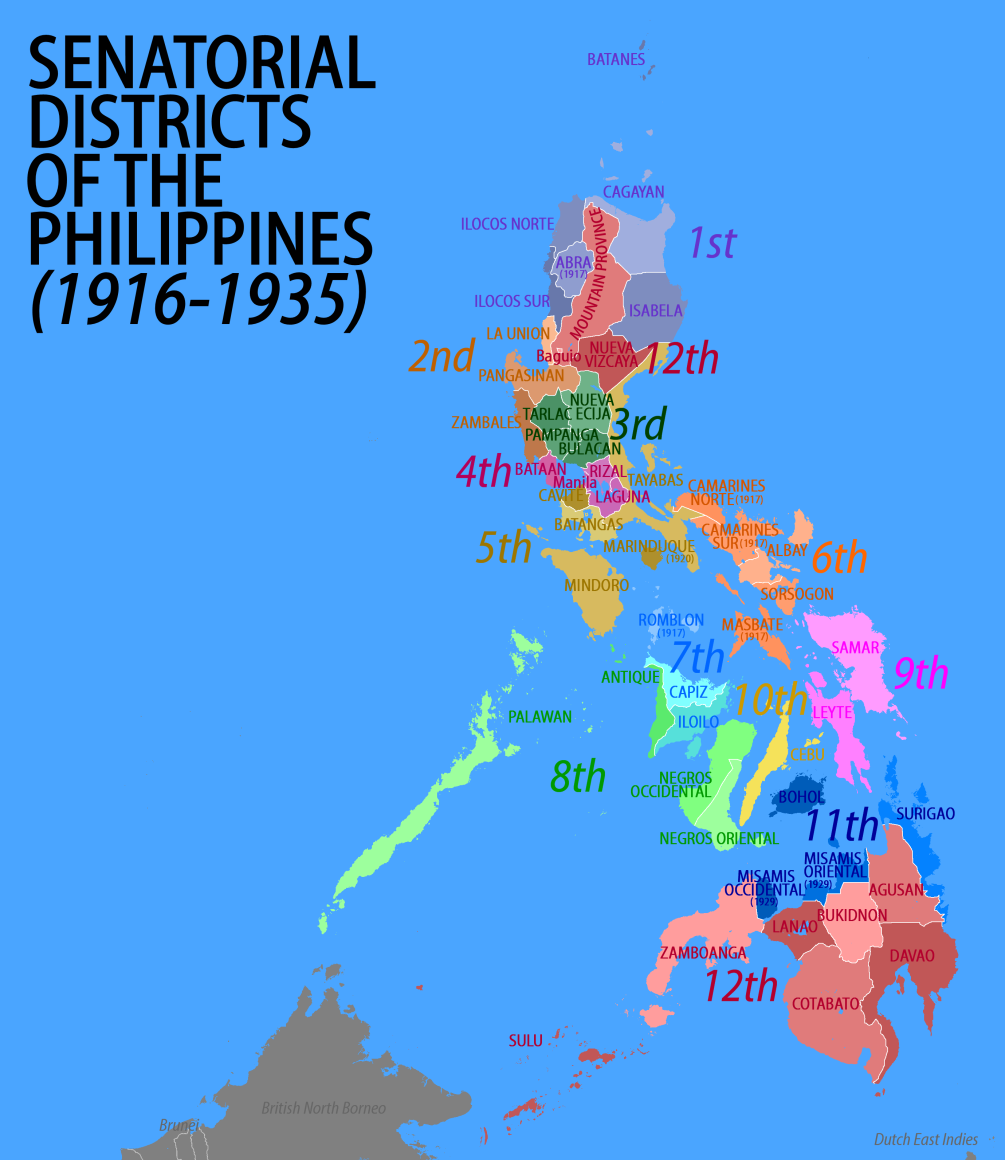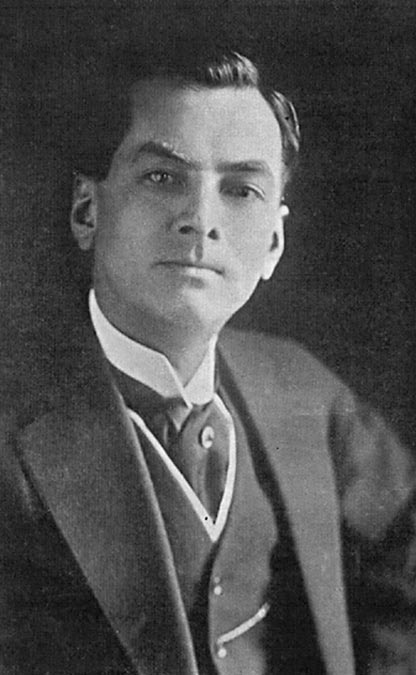|
Philippines's 8th Senatorial District
Philippines's 8th senatorial district, officially the Eighth Senatorial District of the Philippine Islands ( es, Octavo Distrito Senatorial de las Islas Filipinas), was one of the twelve senatorial districts of the Philippines in existence between 1916 and 1935. It elected two members to the Senate of the Philippines, the upper chamber of the bicameral Philippine Legislature under the Insular Government of the Philippine Islands for each of the 4th to 10th legislatures. The district was created under the 1916 Jones Law from the western Visayas provinces of Antique, Negros Occidental, Negros Oriental and Palawan. The district was represented by a total of seven senators throughout its existence. It was abolished in 1935 when a unicameral National Assembly was installed under a new constitution following the passage of the Tydings–McDuffie Act which established the Commonwealth of the Philippines. Since the 1941 elections when the Senate was restored after a constitutional ple ... [...More Info...] [...Related Items...] OR: [Wikipedia] [Google] [Baidu] |
Senatorial Districts Of The Philippines
The senatorial districts of the Philippines were the representations of the provinces of the Philippines in the Philippine Senate from 1916 to 1935. History The enactment of the Philippine Autonomy Act (popularly known as "Jones Law") in August 1916 by the United States Congress provided for the creation of a bicameral legislature consisting of a lower chamber (House of Representatives) and an upper chamber (Senate). Until then the Philippine Commission held the executive power and some legislative powers over the American colony. The system of government of the Philippines in its early years of transition to democratic self-government was deliberately structured to emulate the American model. The Philippines thus followed the American system of electing the members of the 24-seat senate by district. The districts were organized and numbered in a roughly north–south fashion, much like the present administrative regions. The first eleven districts were composed of establish ... [...More Info...] [...Related Items...] OR: [Wikipedia] [Google] [Baidu] |
At-large
At large (''before a noun'': at-large) is a description for members of a governing body who are elected or appointed to represent a whole membership or population (notably a city, county, state, province, nation, club or association), rather than a subset. In multi-hierarchical bodies the term rarely extends to a tier beneath the highest division. A contrast is implied, with certain electoral districts or narrower divisions. It can be given to the associated territory, if any, to denote its undivided nature, in a specific context. Unambiguous synonyms are the prefixes of cross-, all- or whole-, such as cross-membership, or all-state. The term is used as a suffix referring to specific members (such as the U.S. congressional Representative/the Member/Rep. for Wyoming ''at large''). It figures as a generic prefix of its subject matter (such as Wyoming is an at-large U.S. congressional district, at present). It is commonly used when making or highlighting a direct contrast with su ... [...More Info...] [...Related Items...] OR: [Wikipedia] [Google] [Baidu] |
8th Philippine Legislature
The Eighth Philippine Legislature was the meeting of the legislature of the Philippine Islands under the sovereign control of the United States from 1928 to 1930. Members Senate Notes House of Representatives Notes See also * Congress of the Philippines * Senate of the Philippines * House of Representatives of the Philippines External links * * Further reading *Philippine House of Representatives Congressional Library * * {{Philippine legislative periods 08 ... [...More Info...] [...Related Items...] OR: [Wikipedia] [Google] [Baidu] |
1928 Philippine Senate Elections
Legislative elections happened on June 5, 1928, in the Philippines under the Jones Law provisions. Electoral system In a staggered election, the seats of the senators who were first disputed in 1922 were up for election. The Philippines is divided into 12 senatorial districts, of which all districts save for the 12th district, has one of its seats up. In the 12th district, any vacancy is filled via appointment of the Governor-General. The election itself is via first-past-the-post. Results See also *8th Philippine Legislature * Commission on Elections *Politics of the Philippines The politics of the Philippines take place within a three-branch governmental system. The country is a democracy, led by a directly elected president who serves as both the head of state and the head of government. The president heads the execu ... * Philippine elections External linksOfficial website of the Commission on Elections {{Philippine elections 1928 1928 elections in the Phil ... [...More Info...] [...Related Items...] OR: [Wikipedia] [Google] [Baidu] |
1925 Philippine Senate Elections
Senatorial elections happened on June 2, 1925 in the Philippines under the Jones Law provisions. Electoral system In a staggered election, the seats of the senators who were first disputed in 1919 were up for election. The Philippines is divided into 12 senatorial districts, of which all districts save for the 12th district, has one of its seats up. In the 12th district, any vacancy is filled via appointment of the Governor-General. The election itself is via first-past-the-post. Results See also * 7th Philippine Legislature * Commission on Elections *Politics of the Philippines The politics of the Philippines take place within a three-branch governmental system. The country is a democracy, led by a directly elected president who serves as both the head of state and the head of government. The president heads the execu ... * Philippine elections External linksOfficial website of the Commission on Elections {{Philippine elections 1925 1925 elections in the Philip ... [...More Info...] [...Related Items...] OR: [Wikipedia] [Google] [Baidu] |
7th Philippine Legislature
The Seventh Philippine Legislature was the meeting of the legislature of the Philippines under the sovereign control of the United States from 1925 to 1928. Members Senate Notes House of Representatives Notes See also *Congress of the Philippines *Senate of the Philippines *House of Representatives of the Philippines The House of Representatives of the Philippines ( fil, Kapulungan ng mga Kinatawan ng Pilipinas, italic=unset, ''Kamara'' or ''Kamara de Representantes'' from the Spanish word ''cámara'', meaning "chamber") is the lower house of Congress, the ... External links * * Further reading *Philippine House of Representatives Congressional Library * * {{Philippine legislative periods 07 ... [...More Info...] [...Related Items...] OR: [Wikipedia] [Google] [Baidu] |
6th Philippine Legislature
The Sixth Philippine Legislature was the meeting of the legislature of the Philippines under the sovereign control of the United States from 1922 to 1925. Members Senate Notes House of Representatives Notes See also *Congress of the Philippines *Senate of the Philippines *House of Representatives of the Philippines The House of Representatives of the Philippines ( fil, Kapulungan ng mga Kinatawan ng Pilipinas, italic=unset, ''Kamara'' or ''Kamara de Representantes'' from the Spanish word ''cámara'', meaning "chamber") is the lower house of Congress, the ... External links * * Further reading *Philippine House of Representatives Congressional Library * * {{Philippine legislative periods 06 ... [...More Info...] [...Related Items...] OR: [Wikipedia] [Google] [Baidu] |
1922 Philippine Senate Elections
Senatorial elections were held on June 6, 1922 in the Philippines under the Jones Law provisions. It was controversial when Senate President Manuel L. Quezon accused Sergio Osmeña of using public funds in campaigning which resulted to the Nacionalista Party to be split. Electoral system In a staggered election, the seats of the senators who were first place in 1916 were up for election. The Philippines is divided into 12 senatorial districts, of which all districts save for the 12th district, has one of its seats up. In the 12th district, any vacancy is filled via appointment of the Governor-General. The election itself is via first-past-the-post. Results See also * 6th Philippine Legislature *Commission on Elections *Politics of the Philippines *Philippine elections External linksOfficial website of the Commission on Elections {{Philippine elections 1922 Events January * January 7 – Dáil Éireann (Irish Republic), Dáil Éireann, the parliament of the I ... [...More Info...] [...Related Items...] OR: [Wikipedia] [Google] [Baidu] |
1919 Philippine Senate Elections
Senatorial elections happened on June 3, 1919 in the Philippines under the Jones Law provisions. There were 717,295 registered voters, of whom 672,122, or 92 percent, voted. Electoral system In a staggered election, the seats of the senators who were second place in 1916 were up for election. The Philippines is divided into 12 senatorial districts, of which all districts save for the 12th district, has one of its seats up. In the 12th district, any vacancy is filled via appointment of the Governor-General. The election itself is via first-past-the-post. Results See also *5th Philippine Legislature * Commission on Elections *Politics of the Philippines *Philippine elections External linksOfficial website of the Commission on Elections {{Philippine elections 1919 Events January * January 1 ** The Czechoslovak Legions occupy much of the self-proclaimed "free city" of Pressburg (now Bratislava), enforcing its incorporation into the new republic of Czechoslovaki ... [...More Info...] [...Related Items...] OR: [Wikipedia] [Google] [Baidu] |
Hermenegildo Villanueva
Hermenegildo Teves Villanueva (September 25, 1876 – December 17, 1941), fondly called Bindoy, was a Filipino politician. He served as Secretary of Labor for Manuel L. Quezon from December 1938 until his resignation in April 1939. Personal life Villanueva was born on the 25th of September, 1876 in Bais, Negros Oriental, one of the 11 children of Hermenegildo Regis Villanueva and Anselma Pinili Teves. He was privately tutored for primary education and finished secondary and tertiary education in Cebu. Upon finishing his studies, the Spanish–American War erupted and he became one of the leaders in the Negros Revolution. He was married to Asuncion Larena, daughter of Don Demetrio Larena and Maria Luisa de la Peña of Zamboanguita. They had one son, Jesus Pablo Villanueva. He also partnered with Nemecia Diputado and had 5 children. As a sugar planter and progressive agriculturist, he was a long-time member of the board of directors of Central Azucarera de Bais y Tanjay founded ... [...More Info...] [...Related Items...] OR: [Wikipedia] [Google] [Baidu] |
5th Philippine Legislature
The Fifth Philippine Legislature was the meeting of the legislature of the Philippines under the sovereign control of the United States from 1919 to 1922. Members Senate Notes House of Representatives Notes See also *Congress of the Philippines *Senate of the Philippines *House of Representatives of the Philippines The House of Representatives of the Philippines ( fil, Kapulungan ng mga Kinatawan ng Pilipinas, italic=unset, ''Kamara'' or ''Kamara de Representantes'' from the Spanish word ''cámara'', meaning "chamber") is the lower house of Congress, the ... External links * * Further reading *Philippine House of Representatives Congressional Library * * {{Philippine legislative periods 05 ... [...More Info...] [...Related Items...] OR: [Wikipedia] [Google] [Baidu] |
1916 Philippine Senate Elections
The first-ever elections to Philippine Senate were held on October 3, 1916, immediately after the passage of the Philippine Autonomy Act, known as the Jones Law. The Act created the Senate of the Philippines. The Senate replaced the Philippine Commission as the upper house of the Philippine Legislature, thus creating for the first time a fully elected national legislative branch in the Philippines, under the American colonial Insular Government. Each district elected two senators (plurality-at-large): The first-placer was to serve a six-year term while the second-placer was to serve a three-year term. On each election thereafter, one seat per district was up (first past the post). The senators from the 12th district were appointed by the American governor-general for no fixed term. Results References * * See also * 4th Philippine Legislature The Fourth Philippine Legislature was the meeting of the legislature of the Philippine Islands under the sovereign control ... [...More Info...] [...Related Items...] OR: [Wikipedia] [Google] [Baidu] |



